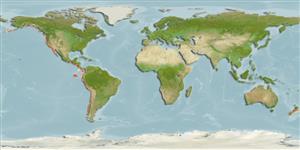Classification / Names
ชื่อสามัญ | ชื่อพ้อง | Catalog of Fishes(สกุล, ชนิด) | ITIS | CoL | WoRMS | Cloffa
>
Ophidiiformes (Cusk eels) >
Bythitidae (Livebearing brotulas)
Etymology: Cataetyx: Greek, kata = down + Greek, etix, stixo, stizo = to prick, to puncture.
More on author: Garman.
Environment: milieu / climate zone / depth range / distribution range
นิเวศวิทยา
เกี่ยวกับทะเล,น้ำเค็ม สัตว์หน้าดินในเขตน้ำลึก; ระดับความลึก 505 - 1300 m (Ref. 38374). Deep-water
Eastern Pacific: Gulf of Panama to Peru.
ขนาด / น้ำหนัก / Age
Maturity: Lm ? range ? - ? cm
Max length : 63.2 cm TL เพศผู้/กระเทย; (Ref. 38374)
Short description
เครื่องมือที่ใช้ในการแยกชนิดสัตว์,สิ่งมีชีวิตออกจากกัน | สัณฐานวิทยา | ความยาวต่างๆ
เงี่ยงครีบหลัง (รวม) : 0; ก้านครีบอ่อนที่หาง (รวม) : 98 - 109; เงี่ยงครีบก้น: 0; ก้านครีบอ่อนที่ก้น: 75 - 85. scales present on body and head; eye diameter less than snout length; prominent opercular spine present; lateral ethmoid bone developed as a sharp retrorse suborbital spine; palatine teeth present; 3 well developed rakers on first arch; male intromittent organ on a broad, fleshy pad or stalk (Ref. 38374).
Rare species (Ref. 34024). Either benthopelagic or demersal (Ref. 34024).
Life cycle and mating behavior
Maturities | การสืบพันธุ์ | Spawnings | Egg(s) | Fecundities | ตัวอ่อน
Nielsen, J.G., D.M. Cohen, D.F. Markle and C.R. Robins, 1999. Ophidiiform fishes of the world (Order Ophidiiformes). An annotated and illustrated catalogue of pearlfishes, cusk-eels, brotulas and other ophidiiform fishes known to date. FAO Fish. Synop. 125(18):178p. Rome: FAO. (Ref. 34024)
IUCN Red List Status (Ref. 130435)
Threat to humans
Harmless
Human uses
การประมง: ไม่มีผลประโยชน์
เครื่องมือ
Special reports
Download XML
แหล่งที่มาจากอินเตอร์เน็ต
Estimates based on models
Preferred temperature (Ref.
123201): 4.5 - 5.2, mean 4.9 °C (based on 13 cells).
Phylogenetic diversity index (Ref.
82804): PD
50 = 0.5002 [Uniqueness, from 0.5 = low to 2.0 = high].
Bayesian length-weight: a=0.00457 (0.00179 - 0.01169), b=3.10 (2.87 - 3.33), in cm total length, based on LWR estimates for this (Sub)family-body shape (Ref.
93245).
ระดับชั้นอาหาร (Ref.
69278): 3.7 ±0.6 se; based on size and trophs of closest relatives
ความสามารถในการกลับคืนสู่ปกติ (Ref.
120179): ต่ำ, เวลาต่ำสุดที่จะทำให้ประชากรเพิ่มขึ้นเป็น 2 เท่าใช้เวลา 4.5 - 14 ปี (Preliminary K or Fecundity.).
Fishing Vulnerability (Ref.
59153): Moderate to high vulnerability (45 of 100).
